Google Pixel 3 vs Apple iPhone XS: which smartphone has the best camera?
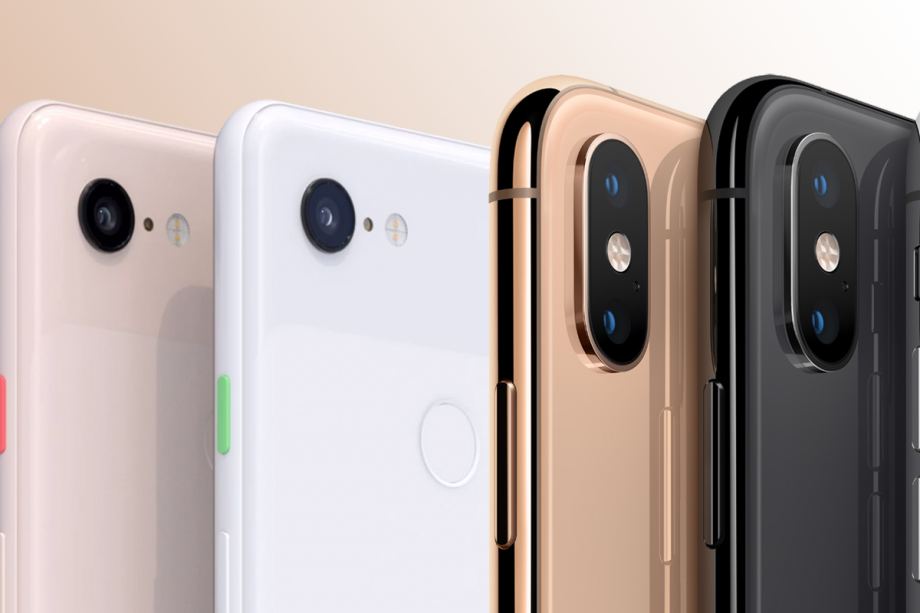
In just a few years, smartphones have gone from being emergency photographic sidekicks to camera-bothering revolutionaries that have just automatically put your DSLR on eBay.
Okay, maybe they’ve still got a little way to go before they can truly match the inherent physical advantages of today’s finest standalone cameras, but they’re catching fast. Take the Google Pixel 3, for example, which is pioneering genuinely innovative computational photography with features like Super Res Zoom (a digital zoom that competes with optical zoom) and its forthcoming Night Sight mode.
But is the Google Pixel 3 really better than another smartphone photography heavyweight, the Apple iPhone XS? After all, Apple is one of the main reasons why your old compact camera cries itself to sleep in your drawer of forgotten gadgets.
To find out, we took both phones on a photographic assault course around London, with tests in five key areas: general shooting, portraits and selfies, zoom, low light and video.
This was a battle between their default, boxfresh shooting experiences, which meant shooting in both phones’ equivalents of ‘auto HDR’ and their stock camera apps.
We then reviewed the snaps on the phone screens and a calibrated monitor to check for mistakes (still quite common in these early days of computational photography), along with colour, white balance, noise and dynamic range.
It was quite a contest – here’s how they got on…
Related: Best camera phones 2019
Google Pixel 3 vs Apple iPhone XS: portrait mode
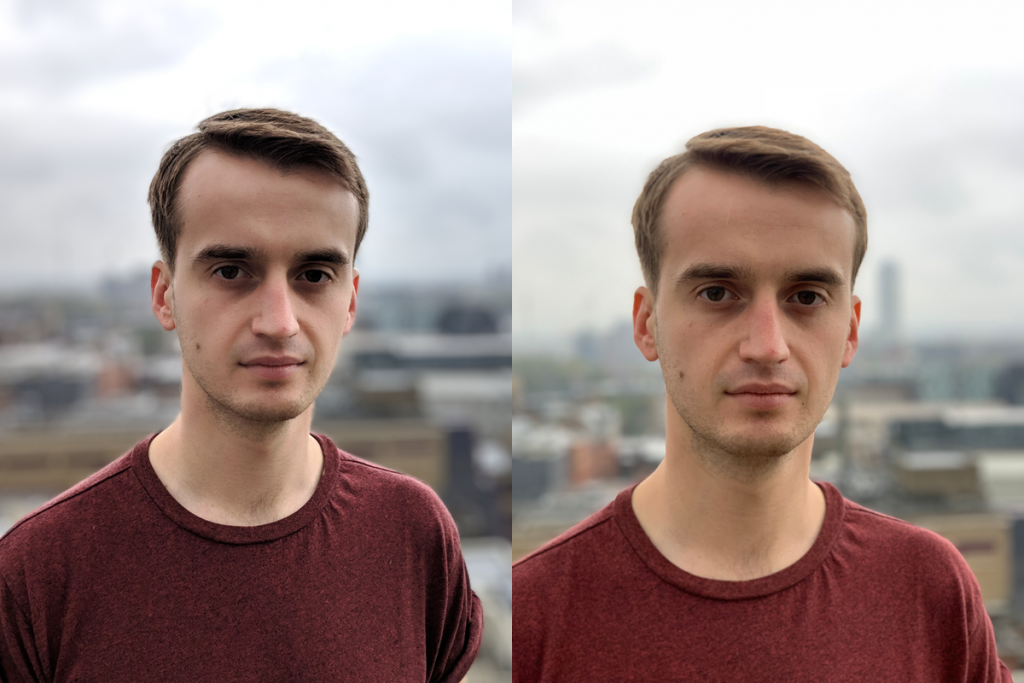
The Google Pixel 3 (left) goes for a more contrasty, sharper look compared to the warmer, softer Apple iPhone XS (right).
One of the biggest differences between the Google Pixel 3 and iPhone XS is in how they handle people shots, at least in their default shooting modes.
Here you can see that the Pixel 3 (left) goes for a cooler, more contrasty look compared the iPhone XS’ warmer tones. Crop into the Pixel’s shot and you can see that it does pick out some extra detail, although its aggressive sharpening can make it pretty unforgiving when it comes to blemishes (sorry, Ryan).
The iPhone XS’ portrait mode is much smoother by comparison – this is more down to its Smart HDR processing than any ‘beauty mode’ effect. Both phones use HDR to merge multiple frames and balance exposure across the frame, but the iPhone’s processing tends to err on the side of removing shadows and local contrast, which makes faces look that bit flatter.
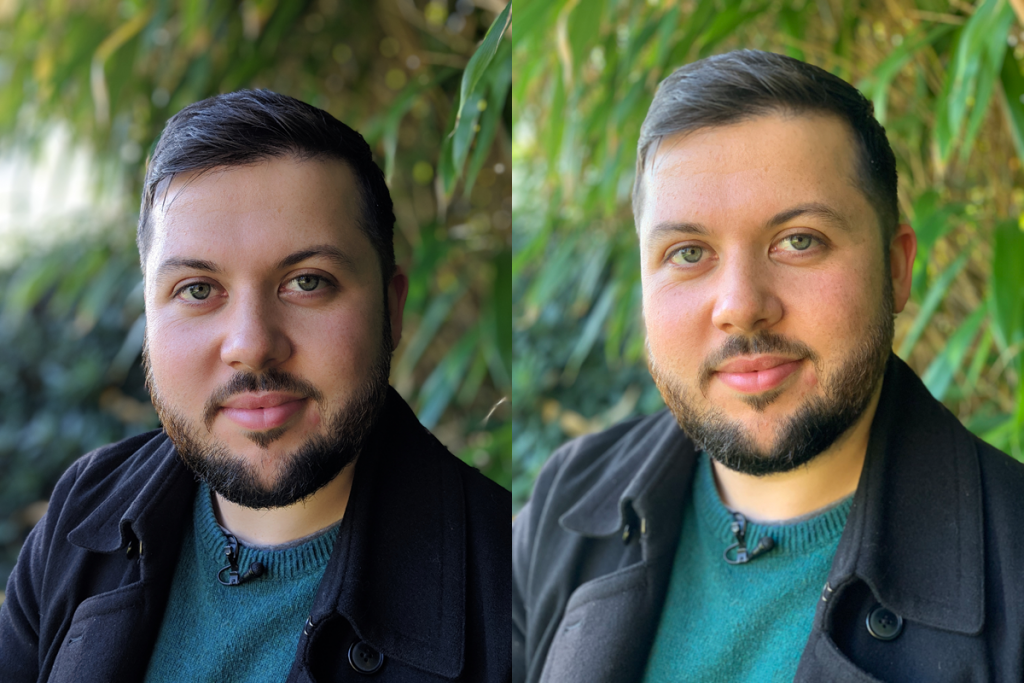
The Pixel 3’s Portrait mode (left) is slightly underexposed here, but picks out more detail than the Apple iPhone XS.
You can see the same effects in the portrait shots above, with the iPhone XS again going for a softer, warmer look. Both phones seem to have improved their edge detection for the fake bokeh, which aims to ape the background blur from a fast lens. But while the Pixel 3 is generally more consistent with its cut-outs, the iPhone XS applies its bokeh effect in a more ‘realistic’ way with gradual blur rather than the more abrupt, cleaner look favoured by the Pixel.
Ultimately, both portrait modes have their flaws, but in a blind poll of the Trusted Reviews office, 80% of voters favoured the more processed look of the Pixel 3’s shots. That extra contrast and detail certainly makes its shots look punchier on a phone screen and on social media, which is surely the destination for most portrait mode snaps. First round to Google, then.
Portrait mode winner: Google Pixel 3
Related: Best smartphones
Google Pixel 3 vs Apple iPhone XS: selfies
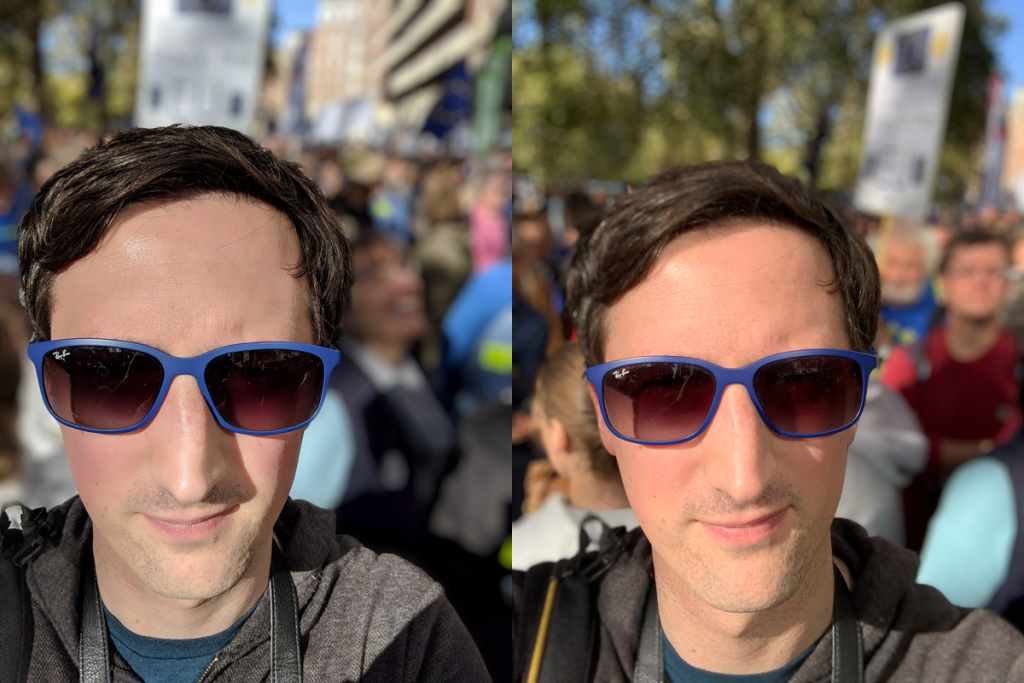
The Pixel 3’s selfies (left) can overdo the sharpening on some occasions, while the iPhone XS (right) removes shadows and flattens faces a little.
It’s a similar story when it comes to both phones’ front-facing cameras – the Google Pixel 3 really goes all-in on sharpness, while iPhone XS selfies are much warmer and smoother.
That extra sharpness on the Pixel can almost give you plastic Lego hair in certain lighting, which may or may not be your preferred look. By contrast, the iPhone XS’ Smart HDR has again removed shadows and depth (no bad thing), while its bokeh effect is more like that of a real, fast lens.
The Pixel 3 has a crucial advantage though – a second, wide-angle lens on the front that gives you the option of fitting a much bigger group of people into your shot. Or, if you don’t have any friends like us, just more background scenery.
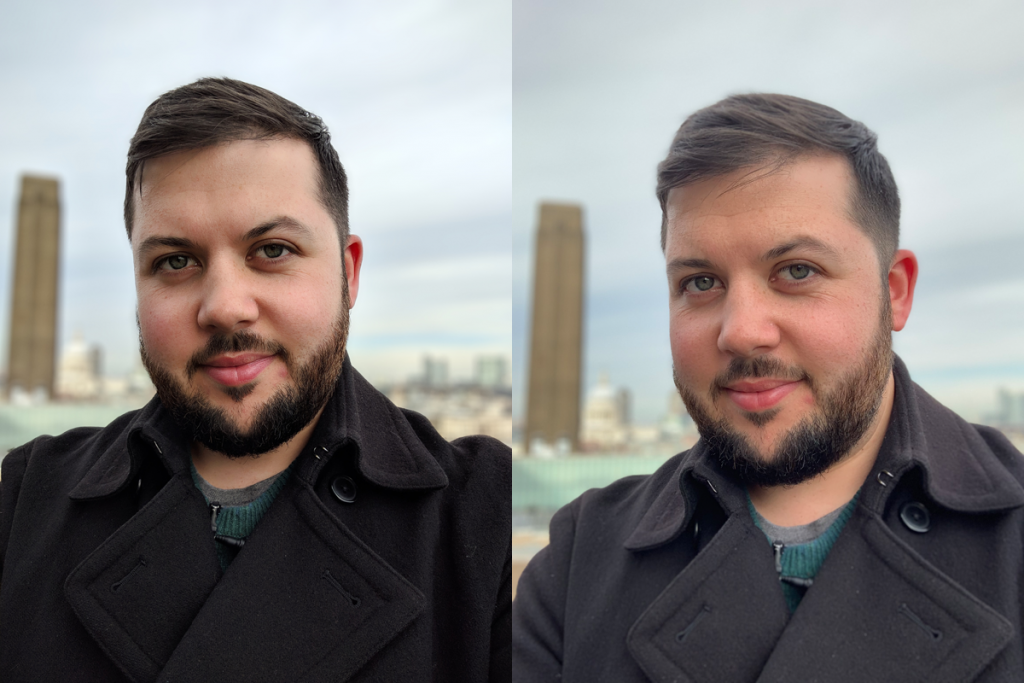
In even lighting, the Pixel 3’s contrasty selfies (left) have more punch than the more true-to-life iPhone XS (right).
It’s the extra flexibility of that second lens, plus the added detail in its shots, that again gives the Pixel 3 the edge in our selfie book.
Selfie winner: Google Pixel 3
Google Pixel 3 vs Apple iPhone XS: zoom
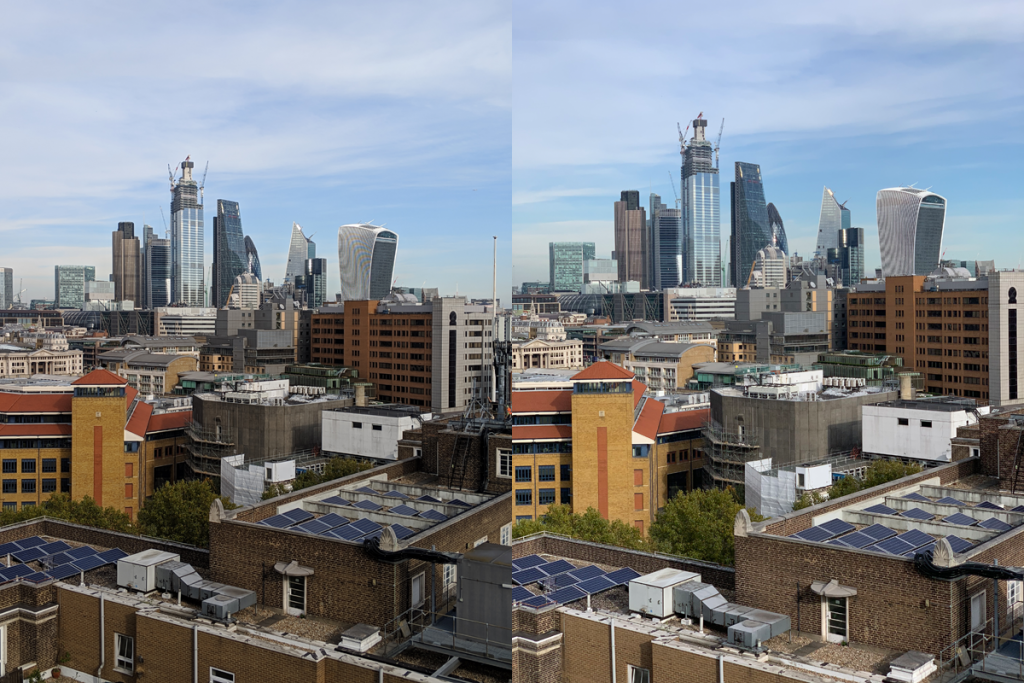
Despite using a new type of digital zoom rather than optical zoom, the Pixel 3 (left) does surprisingly well at 2x zoom compared the iPhone’s dedicated 58mm lens.
So here’s an interesting round – it’s the Google Pixel 3‘s single lens digital zoom versus the iPhone XS‘ 2x optical zoom (from its second 58mm lens). Easy win for the iPhone, right? Surprisingly, it wasn’t quite as simple as that.
On the Pixel 3, Google has done something pretty miraculous in making a digital zoom that you’ll actually want to use. To explain: digital has traditionally just cropped into your image or attempted to recreate information that isn’t there. But the ‘Super Res Zoom’ that debuts on the Pixel 3 instead takes 15 frames in a very quick burst, then uses your hand-shake and optical image stabilisation to do subtle micro shifts and move the lens around, so that extra detail can be localised on the sensor at a sub-pixel level.
Clever stuff, but does it work? As you can see, it does very well compared to the iPhone’s 2x optical zoom. In fact, it’s only when you really look closer with a 100% crop (below) that the Pixel shot starts to break down and turn into more of a painting than a photo. There’s certainly more detail and sharpness in the iPhone’s shot, but the Pixel isn’t miles off.
Related: Best travel cameras
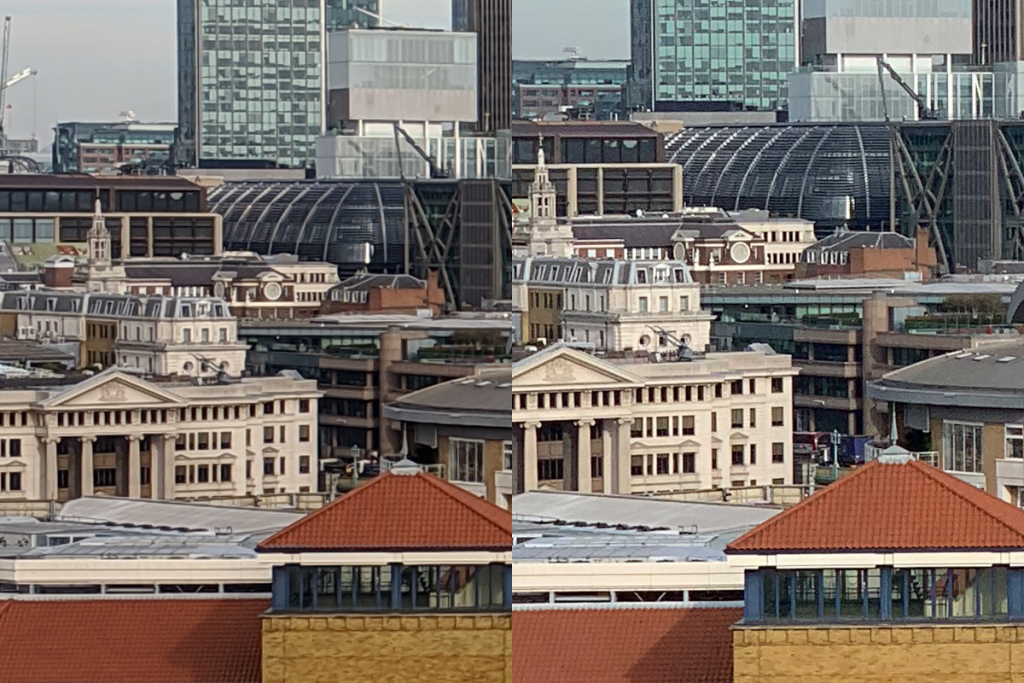
This 100% crop of the previous 2x zoom shot shows that the Pixel 3 (left) does still lack detail and sharpness compared to the optical zoom of the iPhone XS (right).
Google says that Super Res Zoom is “roughly competitive with 2x optical zoom” and that seems about right – it’s better than Pixel 2’s digital zoom and technically impressive, but not quite at optical level yet.
The results are pretty close when you venture into the dangerous waters of 8x zoom too…
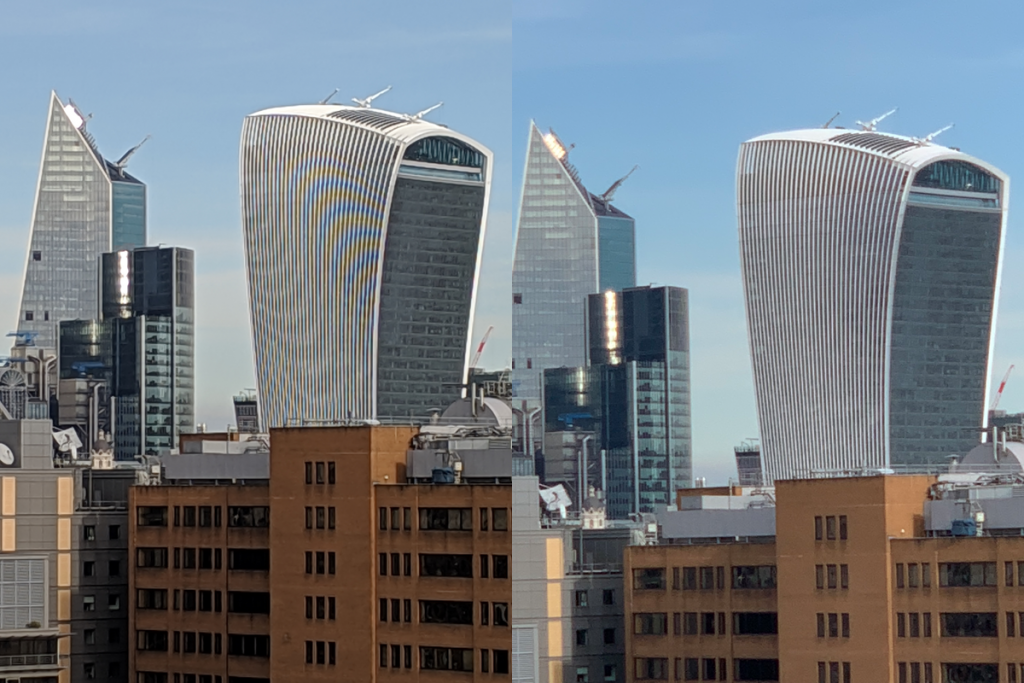
At 8x zoom, both smartphones (Pixel 3 left, iPhone XS right) naturally struggle with intricate patterns and detail.
The Pixel 3 starts to look more like a Prisma art filter when you look closely, particularly in the low light zoom shot below, and there’s a little moiré on the side of the Walkie Talkie building.
But the iPhone’s digital zoom starts to fall apart on close inspection too, particularly in terms of noise. As clever as these phones are, 8x digital zoom is still very much for absolute emergencies.
Related: Best mirrorless cameras
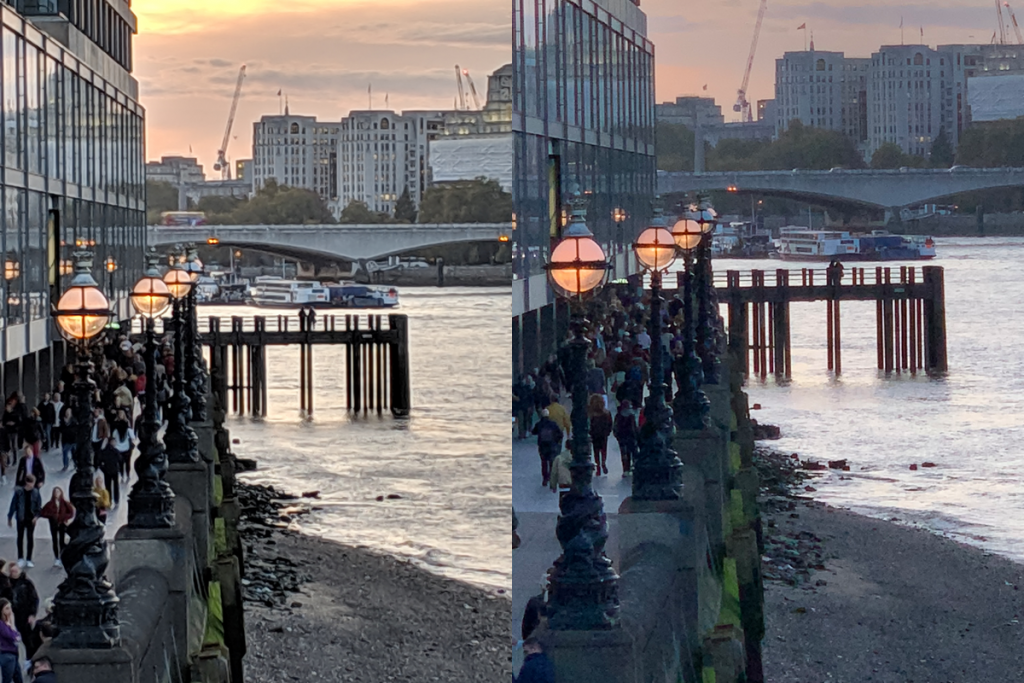
Another 8x zoom snap, which the iPhone XS (right) edges over Pixel 3’s artificial, oversharpened look (left).
So, full marks to Google for rebranding digital zoom as something we might actually use, but this round still goes to the iPhone and its trusty optical zoom.
Zoom winner: Apple iPhone XS
Google Pixel 3 vs Apple iPhone XS: general shooting
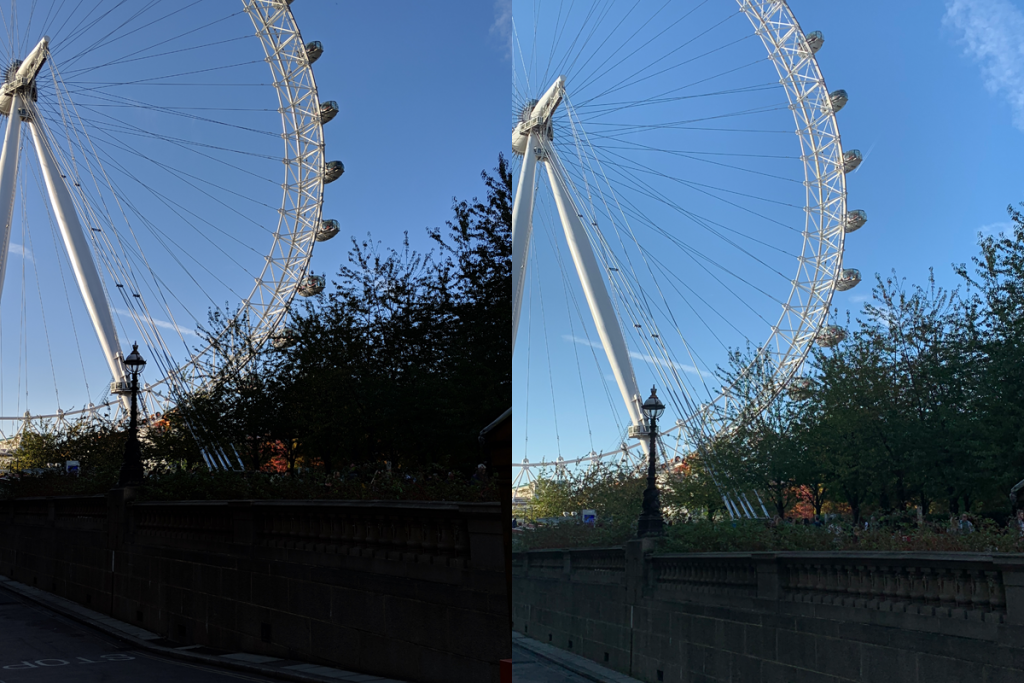
In mixed lighting, the Pixel 3 (left) struggles with dynamic range compared to the iPhone XS’s Smart HDR mode (right).
Stepping back from special modes and fancy computational zooms, how do the two phones fair in simple, point-and-shoot scenarios?
As the photo above shows, it depends very much on the lighting in your scene. In mixed lighting, with dark and bright areas, the iPhone’s Smart HDR (right) tends to come out on top – it’s better exposed across the frame, whereas the Pixel 3 has crushed the blacks, making the trees look more like silhouettes and the wall like it’s been built from dark matter.
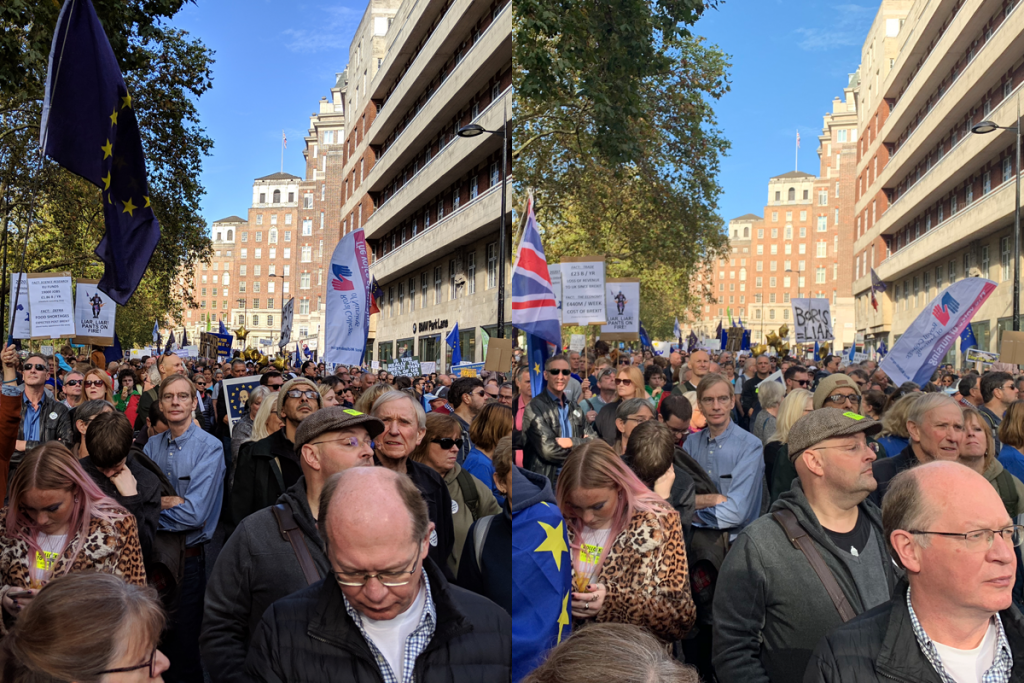
Unlike the previous shot, the Pixel 3 (left) balances the exposure much better here compared to the iPhone XS (right).
Give the phones a balanced diet of more even light, though, and the iPhone XS’ shots can start to look little flat and washed out.
When the Google Pixel 3 gets the exposure right, it just captures that bit more detail than the iPhone too, as you can see in the 100% crop of that photo below. Ignore the pesky flag in the iPhone’s shot, and you can see the extra detail the Pixel manages to capture in the sculpture on the side of the building.
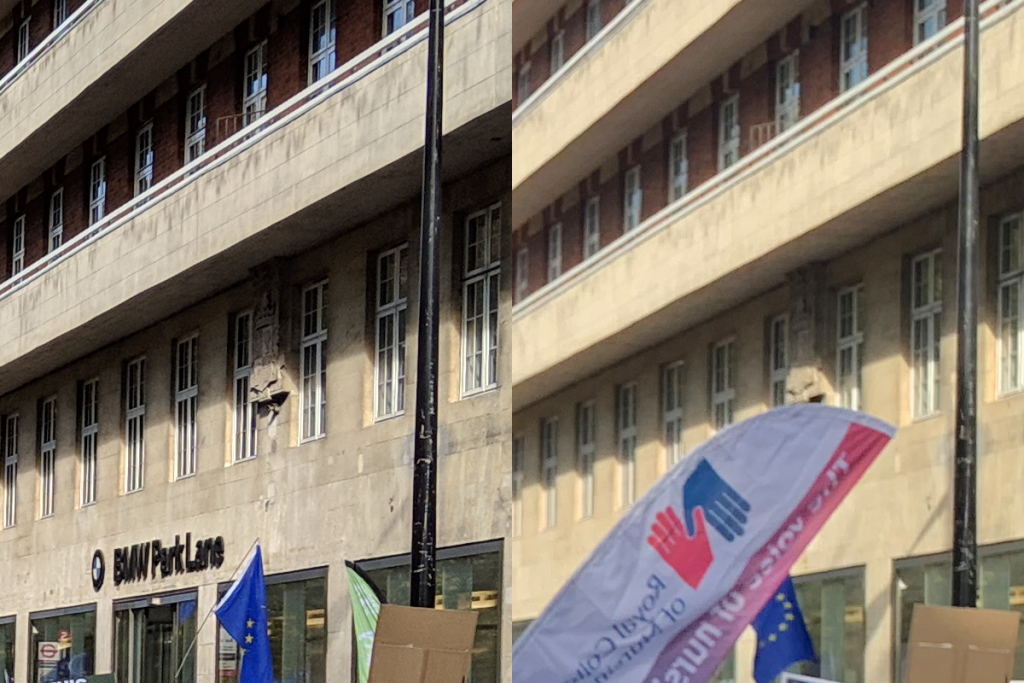
This 100% crop of the previous shot shows how much more detail the Pixel 3 (left) resolves than the iPhone XS (right) in the wall’s sculpture.
With the results so dependent on lighting conditions and both phones scoring winning shots, we’ll have to call this one an honourable draw.
General shooting winner: Draw
Google Pixel 3 vs Apple iPhone XS: low light
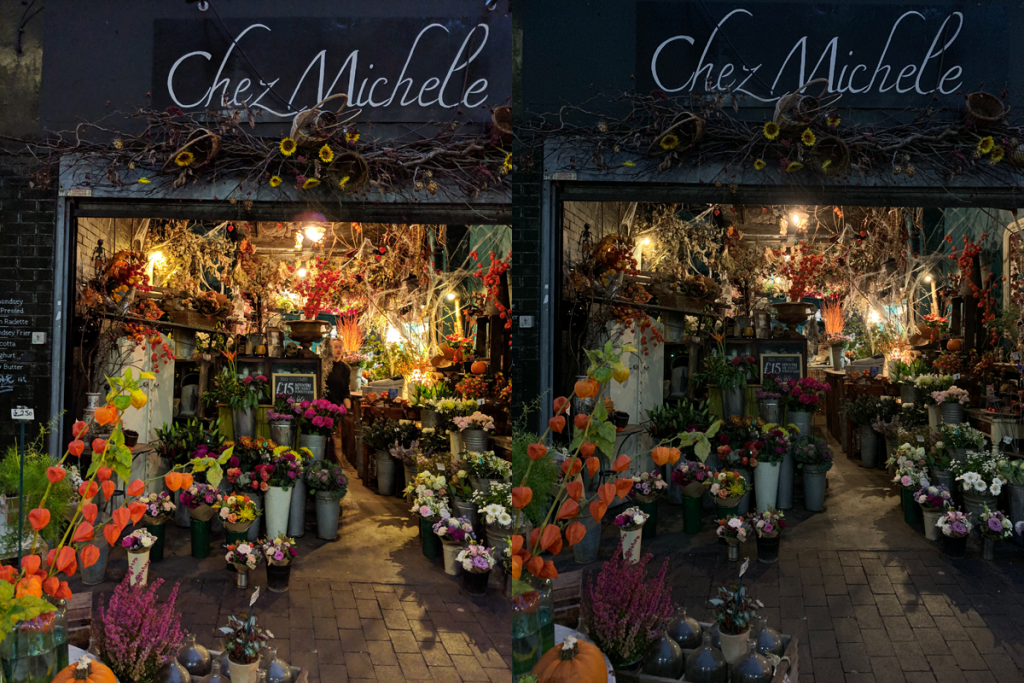
In low light, the iPhone XS (right) favours a more true-to-life exposure than the saturated look of the Pixel 3’s shot (left).
And now we venture into the gloom. Not that this at all intimidates flagship smartphones these days – the performance of both the Google Pixel 3 and iPhone XS in low light shooting is pretty incredible.
The iPhone XS has a larger camera sensor than the iPhone X, and you can see the benefit in its shot (above right). Its noise control is impressive, and it’s done a good job with balancing the exposure between the lights and shadows.
Unfortunately it’s run into a low light ninja in the form of the Pixel 3. Okay, the lights are little more blown out and its colour might be too oversaturated for some, but the levels of detail and sharpness are superb for a smartphone night shot.
The iPhone’s colour and white balance might be more true to the real scene, but there’s no doubting which one stands out more on a phone screen or Instagram.
Related: Best mirrorless cameras
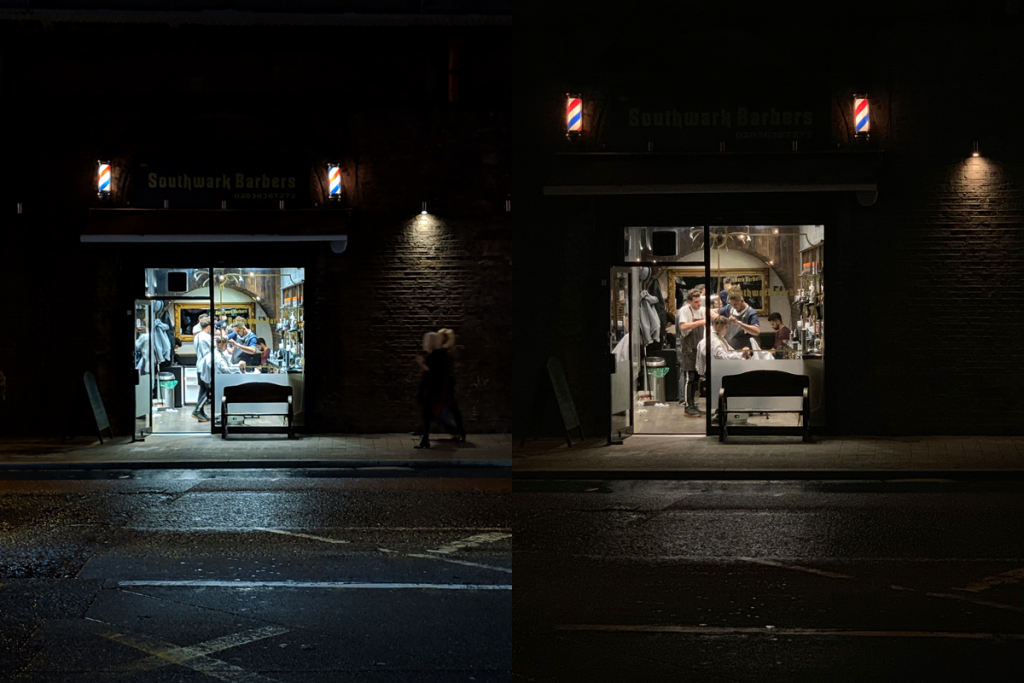
The iPhone XS’s white balance (right) is more accurate here, but the Pixel 3 (left) pulls out much more detail from the shadows.
This shot again shows the two phones’ different low light approaches. The iPhone XS (right) has a more ‘accurate’ white balance that’s close to how the scene looked in real life, with the Pixel taking a much cooler route.
But the Pixel 3’s HDR skills again simply reveal more of the scene, in both the road and in the barber shop’s sign. As the shot below shows, it’s capable of teasing out a little more detail from gloomy scenes too – check out the crop from one of the office windows further down, and you can make out the company name on the cardboard box in the Pixel’s shot. A truly incredible achievement for a handheld night shot.

This shot at dusk shows the differences between the auto white balance of the Pixel 3 (left) and iPhone XS (right).
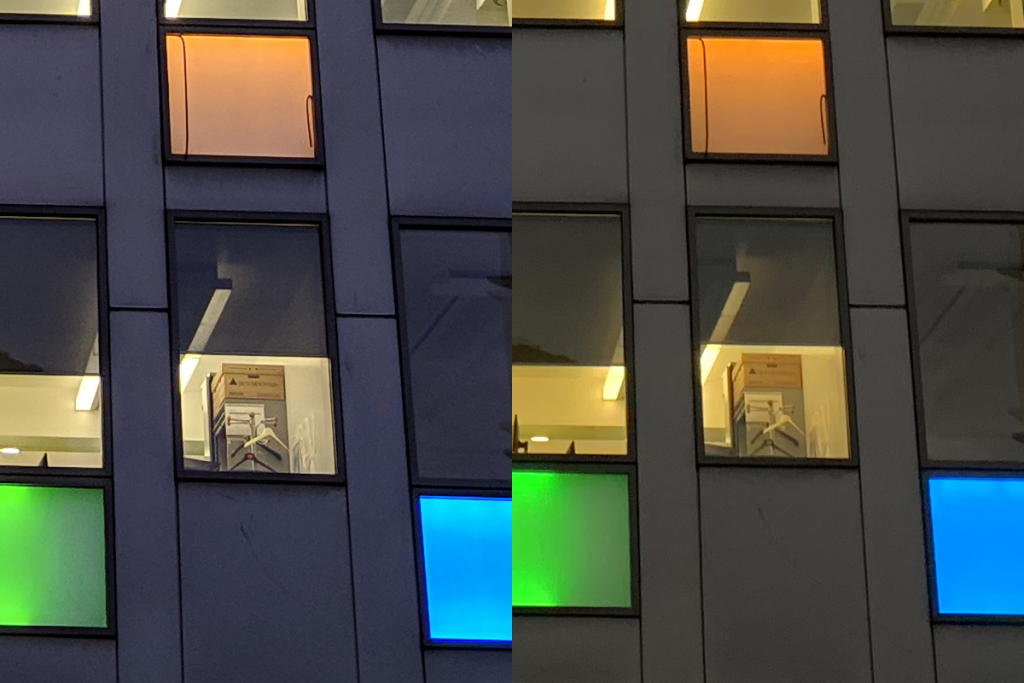
In this 100% crop of the previous shot, the Pixel 3 (left) manages to make the box’s logo decipherable, which is impressive for a handheld night shot.
Google Pixel 3 vs Apple iPhone XS: video
[videoai]The iPhone XS certainly has the edge over the Google Pixel 3 when it comes to video recording specs – it can record 4K up to 60fps (rather than 30fps on the Pixel 3), and you can use its 2x optical zoom when shooting video too.
The colour and dynamic range is impressive, particularly for a smartphone, as is the sound from its stereo mics. The Pixel’s combination of optical and electronic stabilisation works well, but overall the sharpness and sound quality is a little behind the iPhone.
It’s a similar story when it comes to the front-facing cameras, with the Pixel let down by tinny sound quality that pretty much rules it out of vlogging duty.
Video winner: Apple iPhone XS
Google Pixel 3 vs Apple iPhone XS: which smartphone has the best camera?
![]()
And the answer is (drum roll)…it depends what you’re shooting.
That might sound like a cop out, but if there’s one thing this series of tests revealed it’s that these phones (and more specifically, their HDR modes) thrive in different situations.
For daytime scenes with mixed lighting, panoramas, short zooms (up to 2x zoom) and macro close-ups, the iPhone XS wins out. Its photos generally have a more true-to-life look in terms of white balance and colour, and it’s also definitely the best for video.
But overall I’d say the Google Pixel 3 is the slightly better all-rounder for still photos. In even light and low light, it just shoots brighter, crisper and more detailed photos. Its low light performance is already pretty incredible, and there’s still its promising Night Sight mode to come.
You could argue that those who prefer more ‘camera-like’ photos will favour the iPhone’s slightly more restrained processing. But it’s fair to say that most people, as shown by the popularity of the Pixel’s Portrait mode in our blind office test, prefer their smartphones to shoot punchy photos that look great on a phone screen or social media. And for that, the Pixel 3 has the edge.
What do you think, did you prefer the Pixel 3 photos or the iPhone XS snaps in our tests? Drop us a line @TrustedReviews on Twitter.


